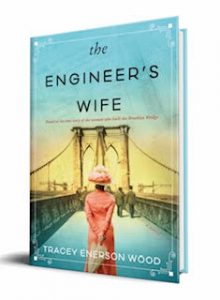My obsession with Emily Warren Roebling and the Brooklyn Bridge
 She built a monument, then was lost in its shadow.
She built a monument, then was lost in its shadow.
My obsession with Emily Warren Roebling and the Brooklyn Bridge
I grew up in northern New Jersey, and New York City was like Oz to us. Not being able to afford the fancy restaurants and shows, we did the free stuff. My father loved to go to the highest points, so we climbed the Statue of Liberty, the Empire State Building and the Twin Towers.
We walked across the George Washington Bridge (which sways, yikes!). And although I don’t recall walking across the Brooklyn Bridge, we frequently admired it from the river shore.
Some years ago, I was writing theatrical plays, and I was brimming with a specific concept, but needed the right story to bring it to life. Coming from a mult-generational military family, the theme I wanted to explore was this: What dynamics are in play, when a family shares a career or occupation through many generations?
What if, like the military, that very occupation that sustains them and binds them together, might also kill them?
I wanted to write a fictionalized version of a real family in such a situation, from the female perspective, but wanted to stray from the well-worn path of military and war. I thought of the photographs of construction workers sitting on skyscraper beams high above the earth, reminding me of the heights I climbed in my youth. But I could find no family story to tell.
So I searched for a woman who did incredible things in a forgotten time, someone who changed history, yet we know little about. I wanted to explore what would happen if that same woman was also blazing forward in a dangerous career path previously followed by the men in the family. In my research, I discovered the Roebling family, and most especially, Emily Warren Roebling.
I was immediately fascinated by Emily, and the times in which she lived. Her pluck, bravery, and sheer determination, in the midst of an enormous task that was destroying her beloved family, was irresistible. I was driven to learn more.
Although there are several books on Washington and John Roebling, Emily’s husband and father-in-law, I could find only one biography, and a children’s book on Emily, and no novels. It seemed a story very worth exploring, and that I was the one who needed to write it.
In my research, I learned many fascinating facts. I knew, of course, that women were not given the right to vote nationally until 1920, but was unaware of the numerous other barriers they faced. Laws restricting their work or what they could wear, for example. Not just societal norms, but actual laws against women wearing pants.
I discovered the incredible hazards faced by the workers, the corrupt political environment of the time, and the many challenges faced building this enormous project in an age of steam power and sheer human physical strength.
I learned that P.T. Barnum was one of the richest and most powerful people in New York at the time, and that he marched his elephants across the bridge to prove its safety. I also learned that his other connections to the bridge are mysteriously missing in history. In my novel, I got to explore what might have happened to silence a most public figure.
But perhaps the most surprising thing was the extent of my heroine’s involvement in completing the Brooklyn Bridge. I have no doubt that if she hadn’t stepped up to the task, the project would have stalled for perhaps decades, changing the development of one the world’s greatest cities. I think I could write another book—an alternative history, where Philadelphia or Newark become the huge fashion, entertainment, and financial powerhouse that is the current New York City.
This story is important even today, because it illustrates the power of a single individual, even one that is challenged at every step, and then hardly recognized for their work, to make huge changes.
I hope readers enjoy this exciting story as much as I enjoyed writing it.
—
Tracey Enerson Wood: Playwright, screenwriter and journalist, Tracey has authored magazine columns and other non-fiction, as well as writing and directing plays of all lengths. Her co-authored anthology/cookbook Homefront Cooking, American Veterans and their Loved Ones share Recipes, Wit, and Wisdom, was released by Skyhorse Publishing in May, 2018, with all authors’ profits donated to organizations that support veterans. The Engineer’s Wife (Sourcebooks, April 2020) is her first novel. See her website at http://traceyenersonwood.
THE ENGINEER’S WIFE

Emily Warren Roebling refuses to live conventionally―she knows who she is and what she wants, and she’s determined to make change. But then her husband Wash asks the unthinkable: give up her dreams to make his possible.
Emily’s fight for women’s suffrage is put on hold, and her life transformed when Wash, the Chief Engineer of the Brooklyn Bridge, is injured on the job. Untrained for the task, but under his guidance, she assumes his role, despite stern resistance and overwhelming obstacles. Lines blur as Wash’s vision becomes her own, and when he is unable to return to the job, Emily is consumed by it. But as the project takes shape under Emily’s direction, she wonders whose legacy she is building―hers, or her husband’s. As the monument rises, Emily’s marriage, principles, and identity threaten to collapse. When the bridge finally stands finished, will she recognize the woman who built it?
Based on the true story of the Brooklyn Bridge, The Engineer’s Wife delivers an emotional portrait of a woman transformed by a project of unfathomable scale, which takes her into the bowels of the East River, suffragette riots, the halls of Manhattan’s elite, and the heady, freewheeling temptations of P.T. Barnum. It’s the story of a husband and wife determined to build something that lasts―even at the risk of losing each other.
Category: Contemporary Women Writers, On Writing
























I caught part of the TV show, “Mysteries at the Museum”, where Mrs. Roeblig’s contributions were detailed. They showed a ribbon that she wore when she took that first walk across the newly completed bridge. But I didn’t hear where this ribbon is currently. I imagine it’s in a museum in New York City somewhere, but that’s a guess. Can you clarify its location please? Thanks.
Hi Lee Anne,
Thanks for writing. No, I haven’t heard of this medal before, interesting! I will keep an eye out for a mention of it.